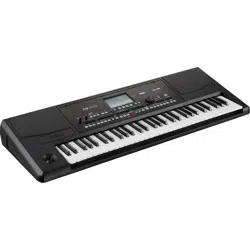Loading ...
Loading ...
Loading ...

260
MIDI
Connecting Pa300 to a personal computer
Connecting Pa300 to a personal computer
You can program a new song on an external sequencer running
on a personal computer, using Pa300 as a multi-timbral
expander.
Connections and settings
In order to connect Pa300 to a computer, you need a computer
with an USB port.
1. Install the Korg USB MIDI Driver, as explained in “Install-
ing the Korg USB MIDI Driver” on page 362.
2. Connect Pa300 and the computer via the USB Device port.
3. Activate the “MIDI Thru” function on the external
sequencer. Please refer to the sequencer’s user manual.
4. On Pa300, select the “Extern.Seq.” MIDI Preset. You can do
this by going to the “MIDI: General Controls” page of the
Global mode. Note that this MIDI Preset will be remain
unchanged even when the instrument enters standby.
5. Go to the “MIDI: General Controls” page, and uncheck the
“Local Control On” parameter (see page 158). This is called
the “Local Off status”.
Note: Settings may change when new Global data is loaded
from a storage device. To protect settings from loading, use
the Global Protect function (see “Global Protect” on
page 154).
6. Press SEQUENCER to go to the Sequencer mode.
7. Play the keyboard. Notes played on the keyboard will go
from the USB port of Pa300 to the USB port of the com-
puter.
Notes generated by the computer (i.e. a song played by its
sequencer) are sent from the USB port of the computer to
the USB port of Pa300.
The Local Off
When Pa300 is connected to an external sequencer, we recom-
mend you to set the Pa300 in Local Off mode (see “Local Con-
trol On” on page 158) to avoid that the notes are simultaneously
played by the keyboard and by the MIDI events sent by the
external sequencer.
When Pa300 is in Local Off, the keyboard of Pa300 transmits
data to the external sequencer, but not to the internal sound gen-
eration. The sequencer will receive notes played on the keyboard
of Pa300 and will send them to the selected track of the song.
The track will then transmit data to the internal sound genera-
tion of Pa300.
Note: In order to send data to the sound generation of Pa300, the
“MIDI Thru” function must be activated in the external sequencer
(normally active; the name may be different according to the type
of sequencer). For more information refer to the instructions man-
ual of the sequencer.
The Sounds
The song that is played back by the sequencer can select Pa300
Sounds through the MIDI messages Bank Select MSB, Bank
Select LSB (bank selection, two messages), and Program Change
(Sound selection). For a list of Sounds and MIDI values, see
“Sounds” on page 266.
As a hint for those who program songs on computer: even
though it is not mandatory, for a wider compatibility you should
set the bass on channel 2, melody on channel 4, drum kit on
channel 10, controls for an harmonizer on channel 5.
Loading ...
Loading ...
Loading ...
